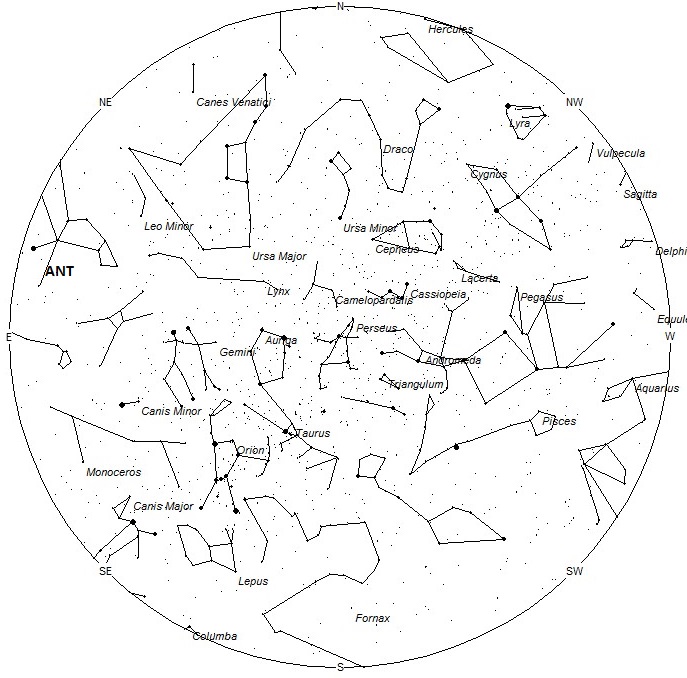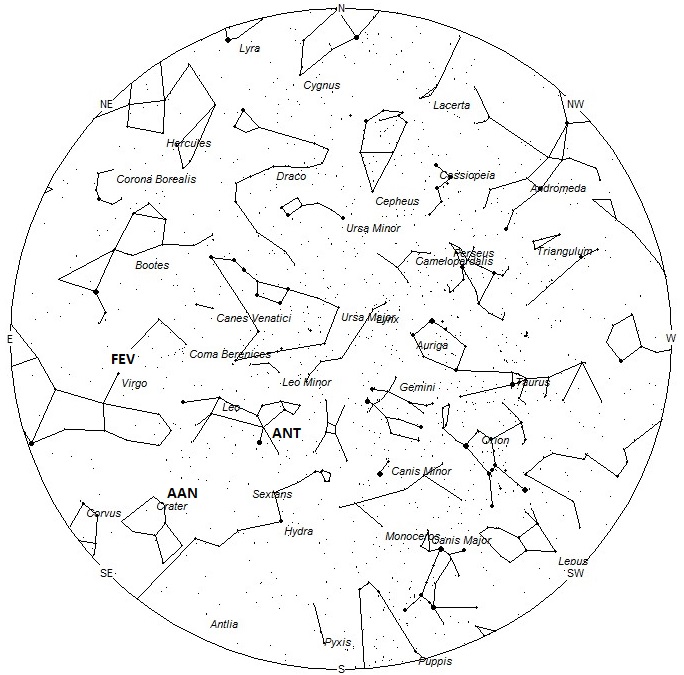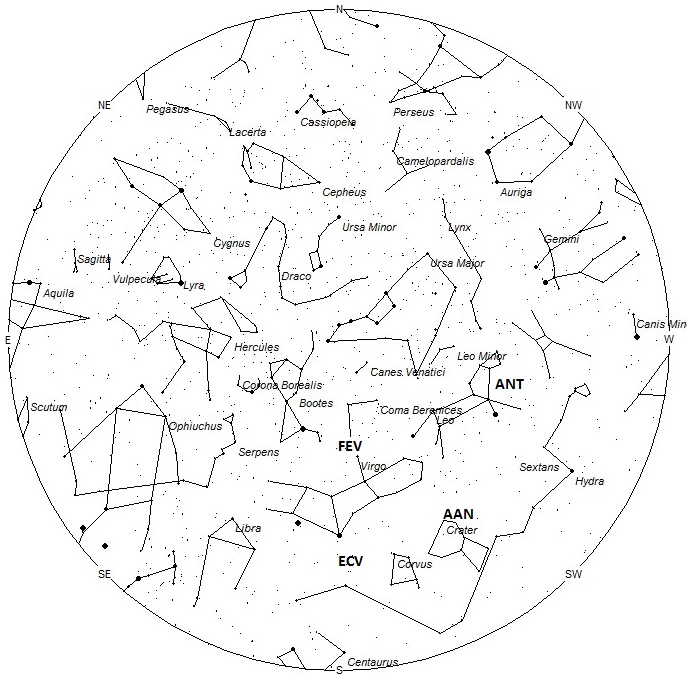During this period the moon will reach its last quarter phase on Sunday January 27th. At this time the moon will be located 90 degrees west of the sun and will rise near midnight local standard time (LST) as seen from mid-northern latitudes. As the week progresses the waning crescent moon will rise later in the morning, allowing a longer window to watch meteor activity under dark skies. Hourly meteor rates for evening observers this week is near 3 as seen from mid-northern latitudes (45N) and 4 as seen from tropical southern locations (25S). For morning observers the estimated total hourly rates should be near 7 as seen from mid-northern latitudes and 10 from the southern tropics. The actual rates will also depend on factors such as personal light and motion perception, local weather conditions, alertness and experience in watching meteor activity. Morning rates are slightly reduced due to moonlight. Note that the hourly rates listed below are estimates as viewed from dark sky sites away from urban light sources. Observers viewing from urban areas will see less activity as only the brighter meteors will be visible from such locations.
The radiant (the area of the sky where meteors appear to shoot from) positions and rates listed below are exact for Saturday night/Sunday morning January 26/27. These positions do not change greatly day to day so the listed coordinates may be used during this entire period. Most star atlases (available at science stores and planetariums) will provide maps with grid lines of the celestial coordinates so that you may find out exactly where these positions are located in the sky. A planisphere or computer planetarium program is also useful in showing the sky at any time of night on any date of the year. Activity from each radiant is best seen when it is positioned highest in the sky, either due north or south along the meridian, depending on your latitude. It must be remembered that meteor activity is rarely seen at the radiant position. Rather they shoot outwards from the radiant so it is best to center your field of view so that the radiant lies near the edge and not the center. Viewing there will allow you to easily trace the path of each meteor back to the radiant (if it is a shower member) or in another direction if it is a sporadic. Meteor activity is not seen from radiants that are located far below the horizon. The positions below are listed in a west to east manner in order of right ascension (celestial longitude). The positions listed first are located further west therefore are accessible earlier in the night while those listed further down the list rise later in the night.
These sources of meteoric activity are expected to be active this week.
The center of the large Anthelion (ANT) radiant is currently located at 09:20 (140) +15. This position lies on the Leo/Cancer border, 12 degrees northwest of the 1st magnitude star known as Regulus (alpha Leonis). Due to the large size of this radiant, Anthelion activity may also appear from Cancer, and northwestern Hydra, as well as western Leo. This radiant is best placed near 0100 local standard time (LST), when it lies on the meridian and is located highest in the sky. Rates at this time should be near 2 per hour as seen from the northern hemisphere and 1 per hour from south of the equator. With an entry velocity of 30 km/sec., the average Anthelion meteor would be of slow velocity.
The alpha Antliids (AAN) should be active from a radiant located near 10:10 (153) -08. This position actually lies in northwestern Crater, 8 degrees north of the 3rd magnitude star known as nu Hydrae. I’m not certain how this stream was named as it the radiant lies a good 20 degrees north of the Antlia border. Perhaps when activity was first noticed from this source the radiant was incorrectly determined? This radiant is best placed near 0200 LST, when it lies on the meridian and is located highest in the sky. Rates are expected to be less than 1 per hour no matter your location. With an entry velocity of 45 km/sec., the average meteor from this source would be of medium velocity.
The February Epsilon Virginids (FEV) were discovered by Kathryn Steakly & Dr. Peter Jenniskens using data from CAMS and SonotaCo. This shower is active from January 29-February 9, with maximum activity occurring on February 3rd. The radiant is currently located at 13:04 (196) +13, which places it in northern Virgo, just 2 degrees north of the 3rd magnitude star known as Vindemiatrix (Epsilon Virginis). These meteors would be best seen near 0400 LST when the radiant lies highest above the horizon. Rates at maximum would be expected to be near 1 per hour during the last dark hour before dawn but the bright moon will make it difficult to view this activity. These meteors are equally well seen from either hemisphere. These meteors encounter the atmosphere at 64 km/sec., which would produce mostly swift meteors.
The last of the eta Corvids (ECV) are expected this weekend from a radiant located at 13:08 (197) -19, which places the radiant in southern Virgo, 4 degrees north of the 3rd magnitude star known as gamma Hydrae. These meteors are best seen near 0400 LST when the radiant lies highest above the horizon. Expected hourly rates would be less than 1 per hour no matter your location. At 68 km/sec. these meteors would be fast.
As seen from the mid-northern hemisphere (45N) one would expect to see approximately 5 sporadic meteors per hour during the last hour before dawn as seen from rural observing sites. Evening rates would be near 2 per hour. As seen from the tropical southern latitudes (25S), morning rates would also be near 9 per hour as seen from rural observing sites and 3 per hour during the evening hours. Locations between these two extremes would see activity between the listed figures. Morning rates are reduced during this period due to moonlight.
| SHOWER | DATE OF MAXIMUM ACTIVITY | CELESTIAL POSITION | ENTRY VELOCITY | CULMINATION | HOURLY RATE | CLASS |
| RA (RA in Deg.) DEC | Km/Sec | Local Standard Time | North-South | |||
| Anthelion (ANT) | – | 09:20 (140) +15 | 30 | 01:00 | 2 – 1 | II |
| alpha Antliids (AAN) | Feb 01 | 10:10 (153) -08 | 45 | 02:00 | <1 – <1 | IV |
| February Epsilon Virginids (FEV) | Feb 03 | 13:04 (196) +13 | 64 | 04:00 | <1 – <1 | IV |
| eta Corvids (ECV) | Jan 22 | 13:08 (197) -19 | 68 | 05:00 | <1 – <1 | IV |








